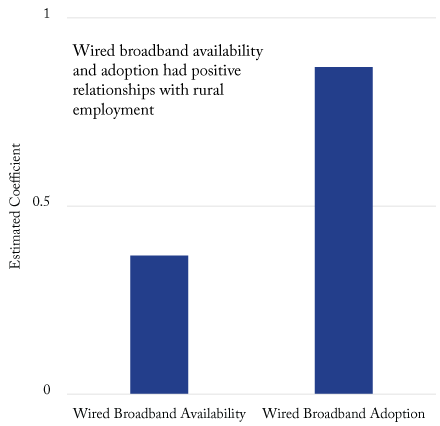In Missouri and across the U.S., an urban-rural “digital divide” often leaves rural areas lacking broadband internet, putting those rural communities at an economic disadvantage. Research has demonstrated how broadband can yield economic benefits such as increasing household incomes and encouraging entrepreneurship.1 The COVID-19 pandemic — a time when Americans increasingly used the internet to buy and sell goods and work from home — further hurt disadvantaged communities not connected to broadband.
This publication highlights findings from a recent MU Extension study that investigated how broadband has affected rural employment. It found that broadband availability and adoption had positive and economically significant impacts on rural employment rates during the COVID-19 pandemic and before the pandemic.
Results suggest that increasing broadband infrastructure availability and adoption should provide economic benefits for rural communities. Understanding how broadband availability and adoption affected rural employment during the pandemic helps to gauge how broadband infrastructure and its uptake may impact rural areas going forward as society relies more on technology.
COVID-19 changed how we work
The COVID-19 pandemic impacted national and state labor markets. Between February and April 2020, the U.S. unemployment rate jumped from 3.5% to 14.7%. In Missouri, the unemployment rate shifted from 3.5% to 9.7%. Labor force participation — measured as a percentage of working-age adults who are employed or actively seeking work — dropped from 63.4% to 60.2% nationwide and 64% to 60.7% in Missouri.
The pandemic also changed work locations for part of the labor force. About 35% of the U.S. workforce worked entirely from home in May 2020 — up from February 2020 estimates that ranged between 8.2% and 15% . A study using nationally representative occupation survey data estimated that 36% of U.S. workers had jobs that could be conducted at home.
Broadband availability and adoption are critical

Although a community may have broadband available, broadband adoption rates may be low. Adoption depends on the regular broadband subscription fees, the one-time hookup costs and a household’s desire for high-speed connectivity.
Prior research has found that broadband adoption has a clearer link to positive economic impacts than broadband availability alone. This suggests availability must be coupled with adoption for communities to experience broadband’s benefits.
MU Extension researchers found that wired broadband availability and wired broadband adoption had positive relationships with rural employment rates during the initial months of the COVID-19 pandemic (Figure 1).2 Wired broadband includes fiber, cable or DSL. The study pointed to inconclusive results for communities with any type of broadband, including fiber, cable, DSL, satellite, fixed wireless or cellular internet.3 Therefore, wired connections contributed more reliably to strengthening rural employment rates.
When analyzing data from the pre-pandemic period of 2020, broadband availability and adoption also positively affected rural employment. This suggests that broadband’s effect on employment rates did not change for rural communities during the pandemic. The relationship also held when researchers studied only the smallest rural communities.

Implications for broadband policy
This research reinforces the importance of broadband availability and adoption in rural America. Federal investment from the Infrastructure Investment and Jobs Act, which appropriated $65 billion for broadband infrastructure and adoption, is flowing.4 Hoping to boost broadband adoption rates, the U.S. began subsidizing broadband subscriptions for low-income households during the pandemic. Limited to the pandemic era, the temporary Emergency Broadband Benefit, which totaled $50 per month per qualifying household, led to fewer new subscribers than anticipated.
The Infrastructure Investment and Jobs Act includes more than $14 billion for the Affordable Connectivity Fund, which will provide a longer term $30 monthly subsidy per qualifying household that may enhance broadband connectivity.
In addition to federal investments, communities may support broadband through efforts such as offering digital literacy training or encouraging rural workers and businesses to utilize the internet more fully. The University of Missouri System and University of Missouri Extension partnered to create the Digitally Connected Community Guide. Presented as a five-step, community-led broadband planning framework that stresses local input and buy-in, the guide emphasizes digital literacy, affordability and adoption and shows how a local commitment to broadband can complement federal investments.5
Despite these opportunities, tight labor market conditions and supply-chain issues, such as fiber cable shortages, are challenging broadband infrastructure rollouts.
Additional resources
This extension publication is based on peer-reviewed research published in early 2022: Catherine Isley, Sarah A. Low. 2022. “Broadband adoption and availability: Impacts on rural employment during COVID-19,” Telecommunications Policy 46(7), 102310.
Learn more about broadband’s impact on Missouri’s economy by visiting the website for MU Extension Exceed.
Endnotes
- For more on broadband’s economic benefits in Missouri, visit the MU Extension Exceed broadband resources webpage.
- Wired broadband availability had a positive impact on the employment rate. A 1 percentage point increase in wired broadband availability increased the employment rate by 0.37 percentage points at the mean employment rate (40.30%) and mean broadband availability (81.52%).Wired broadband adoption had a positive impact on the employment rate. A 1 percentage point increase in wired broadband adoption increased the employment rate by 0.87 percentage points. Of course, wired broadband availability is a prerequisite for wired adoption, so the point estimate on adoption reflects some of the availability effect.
- For more details on different broadband internet technologies, see MU Extension publication DM601, Broadband Technologies: A Primer on Access and Solutions.
This publication was supported in part by the Missouri Agricultural Experiment Station and Enhancing Rural Economic Opportunities (NE1749) regional research committee with long-term support from USDA NIFA.
The authors thank Joe Lear, University of Missouri System; Alice Roach, University of Missouri; and TaylorAnn Washburn, University of Missouri, for their assistance and input.